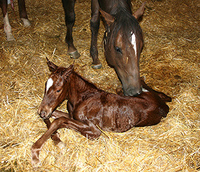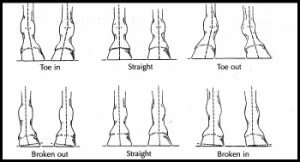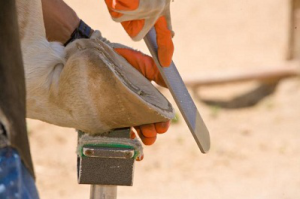 Many horse owners are curious about the right time for their foal’s first trim. Many believe that hoof care is necessary when the foal is a year old or is starting with its riding training. If you are concerned about the welfare of your foal then waiting a year is a big NO. As hooves get long, break or wear unevenly or not break and wear at all, they can potentially cause leg strain and deviation.
Many horse owners are curious about the right time for their foal’s first trim. Many believe that hoof care is necessary when the foal is a year old or is starting with its riding training. If you are concerned about the welfare of your foal then waiting a year is a big NO. As hooves get long, break or wear unevenly or not break and wear at all, they can potentially cause leg strain and deviation.
The more your foal matures the more difficult the corrections will be since as it matures, its bones continue to harden and joints formalize. ALL counteractive efforts and trimming to maintain the right shape and function of the leg should be done before your foal reaches a year old.
In fact, the first trim should be at your foul’s 3 to 4 weeks of age considering its legs are fairly normal and straight. If required, early corrections should be implemented to make big adjustments when it comes to correcting a deviated bone column. As majority of foals are born with several deviations, early corrections can help increase success of corrective trimming efforts.
The right hoof trimming can modify and improve minor deviations as well as maintain the right leg structure for foals born with averagely correct legs and hooves. Conversely, neglecting proper trimming can increase deviations to foals with only minor leg deviations and even to foals born with correctly structured legs.
Foals that are born with major leg and hoof deviations will take more than early hoof trimming methods for their deviations to subside. These foals may need surgery or attention from a veterinarian.
What to look for in a “normal” hoof
A freshly born foal will have front hooves that are fairly pointed. The pointy hooves on the front feet help in the positioning and delivery through the birth canal. In addition, they help rip off the placenta during delivery.
The pointed feet become useless after the foal is born. The pointed hoof prevents the foal from breaking directly over the front of the hoof. This complicates the flight path of the foal allowing it to become toed in (pigeon toed) or toed out (splay footed) (See Image Below). Neglecting this issue will allow further wear during break-over thus resulting to more deviations in the future.
 The ultimate aim of the first trim is to provide a straight break over point on the hoof. This technique will prevent any inward or outward deviation in the leg structure as well as movement pattern. This corrects and reduces additional deviation in the future. The proper first trim can supply a straight and simple break over point for the stride. This fixes minor deviations and provides a straight path for foals having already correct feet and legs needed for maintaining the right bone structure.
The ultimate aim of the first trim is to provide a straight break over point on the hoof. This technique will prevent any inward or outward deviation in the leg structure as well as movement pattern. This corrects and reduces additional deviation in the future. The proper first trim can supply a straight and simple break over point for the stride. This fixes minor deviations and provides a straight path for foals having already correct feet and legs needed for maintaining the right bone structure.
Trimming regularly every three to four weeks after the first trim will allow the solidification of the bony column in as correct and straight a line as possible. Remember to start the first trim earlier before your foal is a year old and practice the method throughout the life of your horse to improve its performance and function.

